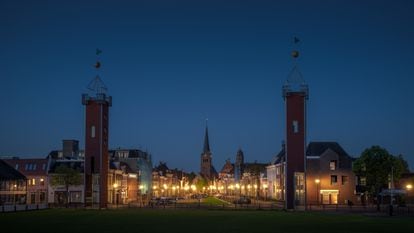"Turn off the light and turn on the stars." It sounds poetic, even musical, and it's what the Dutch artist, architect and designer Daan Roosegaarde (Nieuwkoop, 42) did in the Frisian town of Franeker, in the north of the Netherlands. One cloudless night last summer, and with the support of the City Council and the collaboration of UNESCO in the Netherlands, he kept only essential urban lights there until dawn. Without the barrier of light pollution, "arose the landscape of the sky that has always accompanied us and to which we do not pay attention". He says it hours before the world presentation, this Tuesday, of his new project, called
Seeing Stars
(see the stars), which he hopes to take to other cities.
From Reykjavik to Sydney, and from Stockholm to Venice.
A controlled blackout without compromising public safety.
Contemplating the sky in unison without breaking the restrictions of the pandemic, when being together is difficult and meeting is a challenge.
More information
The artist who 'floods' cities to talk to you about climate change
'Seeing Stars' by Studio Roosegaarde.Albert Dros and Merel Tuk
Roosegaarde is a kind of technical poet who had been thinking about the 2007 Unesco declaration in defense of the night sky and the right to observe the stars. In which heaven is our common and universal heritage. "I told myself that I needed a place where the lights could be turned off to look up without barriers," as he explains in a video interview, shortly before the premiere of the film about the experience, also named
Seeing Stars.
. It is a work that joins the informal movement called Dark Skies, promoted by professional and amateur astronomers to reduce light pollution. The designer focuses on recovering the beauty of starlight and has not had to add anything of his own. As he puts it: "The starlight was a click away and I just needed to convince a mayor to turn off all the non-essential lights." It was a mayor, the social democrat Marga Waanders, and he found her in that city in the Dutch province of Friesland. With just 13,000 inhabitants, Franeker is famous throughout the country because it is home to the oldest mechanical planetarium in the world. Built by the local astronomer Eise Eisinga, it was completed in 1781. It was certainly the right place for a company like this.
'Seeing Stars' by Studio Roosegaarde.
Studio roosegaarde
Dispensing for a few hours of non-essential lighting required many hours of negotiation and management.
The first attempt was considered a trial.
When everything was ready, the urban lighting was switched off in a controlled way.
"When our eyes got used to the darkness, the starry sky came back," he recalls.
“It was not necessary to use telescopes;
it was all up there on a cloudless evening.
We saw shooting stars and filmed without additional technological help.
What the movie shows
It is what there was ”, he assures.
It was a show that he describes “as if it were a luminous performance that takes place every night in the sky without our noticing it, and that we have tried to bring closer to the streets of the city.
Especially now, that we are in a certain way in our own bubble and more disconnected from each other due to the pandemic ”.
He adds that it was "a moment of silence, of feeling in community, and also of admiration."
When it dawned, the people gathered in Franeker believed that the lights of the city were returning, but it was sunrise.
'Seeing Stars' by Studio Roosegaarde.Albert Dros and Merel Tuk
To date, Roosegaarde's blend of art, architecture, and imagination has yielded unexpected results for the public. It has used beams of lights that point to space debris in orbit around the Earth - some 29,000 objects larger than 10 centimeters - to warn of off-planet pollution. And with an eye to capturing and transforming that waste. It has built a seven-meter-high tower designed to eliminate suspended particles from urban pollution. It's called
Smog Free Tower
, and it has traveled to different places, including Beijing (China). He has simulated the rise of the sea with LED lights in
Waterlicht
. He has literally lit the path to sustainable agriculture with
Grow
, a light installation designed to promote the growth of crops with the help of ultraviolet, red and blue lights. It has been inspired by Van Gogh's starry sky to create a fluorescent path that has a solar-powered coating, and can glow for several hours. It is in the city of Nuenen, in the south of the Netherlands, where the painter lived with his parents between 1883 and 1885. Last March he presented
Urban Sun
, which aims to disinfect outdoor spaces with ultraviolet light to reduce the risk of contagion. of the coronavirus.
Seeing Stars
launches now, but Roosegaarde and his team's next job is almost done.
In January, they hope to present organic fireworks that do not pollute and produce the same visual effect.
They have already tried them and he says they meet expectations.
Meanwhile, he likes to remember a phrase by the American architect Richard Buckminster Fuller, also a visionary of environmental protection and creator of the geodesic dome.
It said this: "We are the astronauts of a small spaceship called Earth", which must be cared for.
This Tuesday, the Dutch designer will turn off the lights in his studio in Rotterdam to gaze at the stars and contribute to the collective experience he seeks.
"Hopefully there are no clouds," he murmurs, in his farewell.

